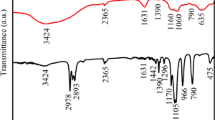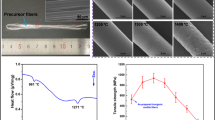Abstract
In the present work, homogeneous and flexible mullite nanofibers were successfully prepared by electrospinning method through the conventional diphasic mullite sol–gel route for the first time. Alumina sol prepared using aluminum acetate (stabilized with boric acid) was mixed with colloidal silica to prepare the precursor mullite sol. Polyvinyl pyrrolidone (PVP) was applied as polymer additive. General rules for preparing desired as-spun nanofibers and fiber morphological evolution were discussed, and elemental analyses and mechanical properties of mullite nanofibers were studied. It was found that uniform as-spun nanofibers were obtained when the mass ratio of PVP solution to precursor sol was 1.5. Upon calcining, Al4B2O9 and Al18B4O33 phase formed instead of γ-Al2O3 due to the introduction of boron. Average fiber diameter decreased unceasingly with the calcination temperatures increased from 800 to 1200 °C because of the densification related to the phase transformation and the presented amorphous SiO2. After calcining at 1000 °C, relatively smooth fiber surface was obtained owing to the self-repairing ability for surface defects. Mullite nanofibers with preferable morphology possessed Al/Si molar ratio of 2.98, homogeneous elemental distribution, elastic modulus of 25.18 ± 1.29 GPa and outstanding flexibility.










Similar content being viewed by others
References
Wang Y, Cheng H, Liu H, Wang J (2013) Microstructure and room temperature mechanical properties of mullite fibers after heat-treatment at elevated temperatures. Mater Sci Eng A 578:287–293
Schawaller D, Clauß B, Buchmeiser MR (2012) Ceramic filament fibers—a review. Macromol Mater Eng 297:502–522
Bunsell AR, Berger MH (2000) Fine diameter ceramic fibres. J Eur Ceram Soc 20:2249–2260
Dong X, Sui G, Guo A et al (2015) Synthesis and properties of lightweight flexible insulant composites with a mullite fiber-based hierarchical heterostructure. Chem Eng J 277:159–167
Wilson DM, Visser LR (2001) High performance oxide fibers for metal and ceramic composites. Compos Part A Appl Sci Manuf 32:1143–1153
Koch D, Tushtev K, Grathwohl G (2008) Ceramic fiber composites: experimental analysis and modeling of mechanical properties. Compos Sci Technol 68:1165–1172
Si Y, Yu J, Tang X et al (2014) Ultralight nanofibre-assembled cellular aerogels with superelasticity and multifunctionality. Nat Commun 5:1–9
Wang H, Zhang X, Wang N et al (2017) Ultralight, scalable, and high-temperature–resilient ceramic nanofiber sponges. Sci Adv 3:1–10
Wu H, Pan W, Lin D, Li H (2012) Electrospinning of ceramic nanofibers: fabrication, assembly and applications. J Adv Ceram 1:2–23
Wu J, Lin H, Li J-B et al (2009) Fabrication and characterization of electrospun mullite nanofibers. Mater Lett 63:2309–2312
Mohammad Ali Zadeh M, Keyanpour-Rad M, Ebadzadeh T (2014) Effect of viscosity of polyvinyl alcohol solution on morphology of the electrospun mullite nanofibres. Ceram Int 40:5461–5466
Peng C, Liu P, Hu J et al (2014) Preparation of uniaxially aligned mullite ceramic fibers by electrospinning. Colloids Surf A Physicochem Eng Asp 457:1–7
Cividanes LS, Campos TMB, Rodrigues LA et al (2010) Review of mullite synthesis routes by sol–gel method. J Sol–Gel Sci Technol 55:111–125
Sowman HG (1974) Aluminum borate and aluminum borosilicate articles. U.S. Patent 3,795,524
Schmücker M, Flucht F, Schneider H (1996) High temperature behaviour of polycrystalline aluminosilicate fibres with mullite bulk composition. I. Microstructure and strength properties. J Eur Ceram Soc 16:281–285
Mohammad Ali Zadeh M, Keyanpour-Rad M, Ebadzadeh T (2013) Synthesis of mullite nanofibres by electrospinning of solutions containing different proportions of polyvinyl butyral. Ceram Int 39:9079–9084
Wu J, Lin H, Li J et al (2010) Synthesis and characterization of electrospun mullite nanofibers. Adv Eng Mater 12:71–74
Zhou J, Sun G, Zhao H et al (2015) Tunable white light emission by variation of composition and defects of electrospun Al2O3–SiO2 nanofibers. Beilstein J Nanotechnol 6:313–320
Wei H, Li H, Cui Y et al (2017) Synthesis of flexible mullite nanofibres by electrospinning based on nonhydrolytic sol–gel method. J Sol–Gel Sci Technol 82:718–727
Dong X, Liu J, Li X et al (2017) Electrospun mullite nanofibers derived from diphasic mullite sol. J Am Ceram Soc 100:3425–3433
Richards EA, Goodbrake CJ, Sowman HG (1991) Reactions and microstructure development in mullite fibers. J Am Ceram Soc 74:2404–2409
Tan EPS, Lim CT (2006) Effects of annealing on the structural and mechanical properties of electrospun polymeric nanofibres. Nanotechnology 17:2649–2654
Ding Y, Zhang P, Jiang Y et al (2009) Mechanical properties of nylon-6/SiO2 nanofibers prepared by electrospinning. Mater Lett 63:34–36
Song X, Liu W, Wang J et al (2017) Microstructural differences between electrospun alumina borate nanofibers prepared by solutions with different PVP contents. Ceram Int 43:9831–9837
Dai Y, Liu W, Formo E et al (2011) Ceramic nanofibers fabricated by electrospinning and their applications in catalysis, environmental science, and energy technology. Polym Adv Technol 22:326–338
Liu P, Zhu Y, Ma J et al (2013) Preparation of continuous porous alumina nanofibers with hollow structure by single capillary electrospinning. Colloids Surf A Physicochem Eng Asp 436:489–494
Zeng L, Weber AP (2014) Aerosol synthesis of nanoporous silica particles with controlled pore size distribution. J Aerosol Sci 76:1–12
Zhihong L, Shiyang G, Shuping X (2003) FT-IR spectroscopic study of phase transformation of chloropinnoite in boric acid solution at 303 K. Spectrochim Acta Part A Mol Biomol Spectrosc 59:265–270
Fu Q, Cao CB, Zhu HS (1999) Preparation of alumina films from a new sol–gel route. Thin Solid Films 348:99–102
Zhang Y, Ding Y, Gao J, Yang J (2009) Mullite fibres prepared by sol–gel method using polyvinyl butyral. J Eur Ceram Soc 29:1101–1107
Leivo J, Lindén M, Rosenholm JM et al (2008) Evolution of aluminosilicate structure and mullite crystallization from homogeneous nanoparticulate sol–gel precursor with organic additives. J Eur Ceram Soc 28:1749–1762
Beran A, Voll D, Schneider H (2001) Dehydration and structural development of mullite precursors: an FTIR spectroscopic study. J Eur Ceram Soc 21:2479–2485
Ksapabutr B, Gulari E, Wongkasemjit S (2004) Sol–gel transition study and pyrolysis of alumina-based gels prepared from alumatrane precursor. Colloids Surf A Physicochem Eng Asp 233:145–153
Jing C, Zhao X, Zhang Y (2007) Sol–gel fabrication of compact, crack-free alumina film. Mater Res Bull 42:600–608
Borodko Y, Habas SE, Koebel M et al (2006) Probing the interaction of poly(vinylpyrrolidone) with platinum nanocrystals by UV-Raman and FTIR. J Phys Chem B 110:23052–23059
Lührs H, Fischer RX, Schneider H (2012) Boron mullite: formation and basic characterization. Mater Res Bull 47:4031–4042
Zhang G, Fu Z, Wang Y et al (2010) Boron-doped mullite derived from single-phase gels. J Eur Ceram Soc 30:2435–2441
Sowman HG (1988) Alumina–boria–silica ceramic fibers from the sol–gel process. In: Klein LC (ed) Sol–gel technology for thin films, fibers, performs, electronics, and specialty shapes. Noyes Publications, Park Ridge, pp 162–182
Saruhan B, Albers W, Schneider H, Kaysser WA (1996) Reaction and sintering mechanisms of mullite in the systems cristobalite/α-Al2O3 and amorphous SiO2/α-Al2O3. J Eur Ceram Soc 16:1075–1081
Salomão R, Fernandes L (2017) Porous co-continuous mullite structures obtained from sintered aluminum hydroxide and synthetic amorphous silica. J Eur Ceram Soc 37:2849–2856
Hong SH, Cermignani W, Messing GL (1996) Anisotropic grain growth in seeded and B2O3-doped diphasic mullite gels. J Eur Ceram Soc 16:133–141
Stachewicz U, Stone CA, Willis R, Barber AH (2012) Charge assisted tailoring of chemical functionality at electrospun nanofiber surfaces. J Mater Chem 22:22935–22941
Song X, Liu W, Xu S et al (2018) Microstructure and elastic modulus of electrospun Al2O3–SiO2–B2O3 composite nanofibers with mullite-type structure prepared at elevated temperatures. J Eur Ceram Soc 38:201–210
Acknowledgements
The authors gratefully acknowledge the financial support from the “Chang Jiang Scholars Program” of the Ministry of Education of China (Grant No. T2011119).
Author information
Authors and Affiliations
Corresponding authors
Ethics declarations
Conflict of interest
The authors declared that they have no conflict of interest.
Rights and permissions
About this article
Cite this article
Song, X., Ma, Y., Wang, J. et al. Homogeneous and flexible mullite nanofibers fabricated by electrospinning through diphasic mullite sol–gel route. J Mater Sci 53, 14871–14883 (2018). https://doi.org/10.1007/s10853-018-2667-8
Received:
Accepted:
Published:
Issue Date:
DOI: https://doi.org/10.1007/s10853-018-2667-8




